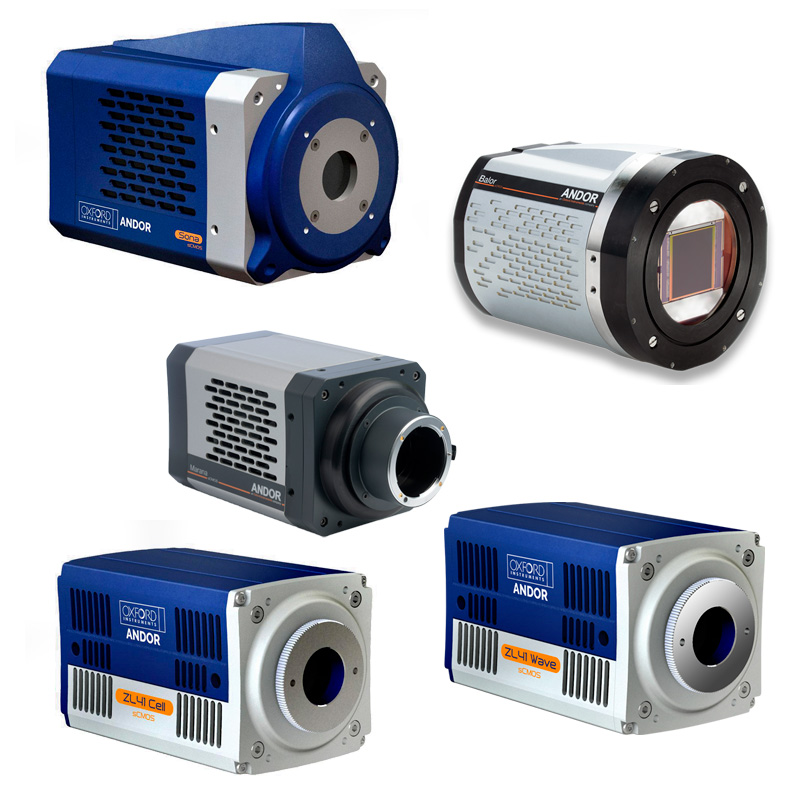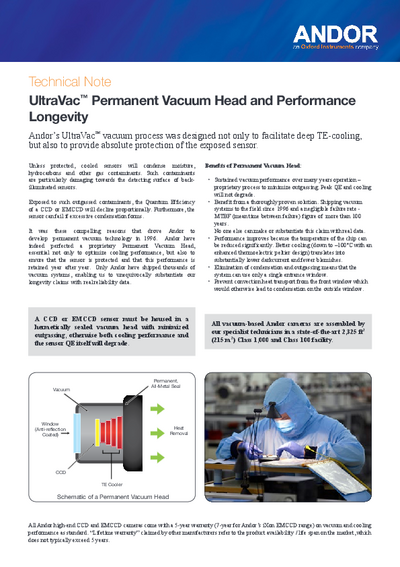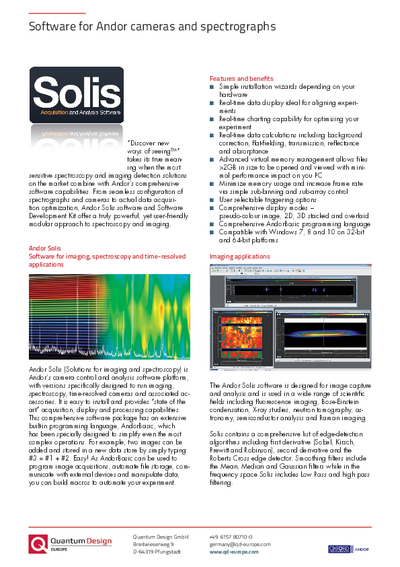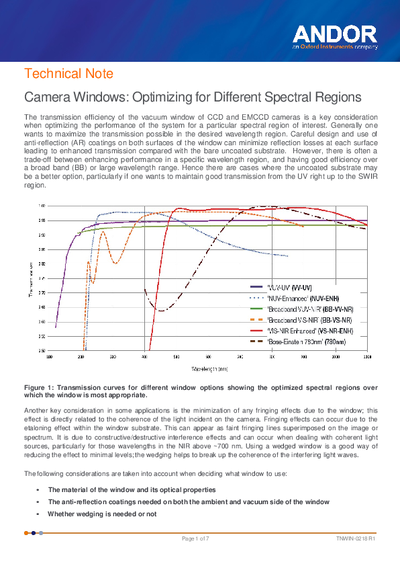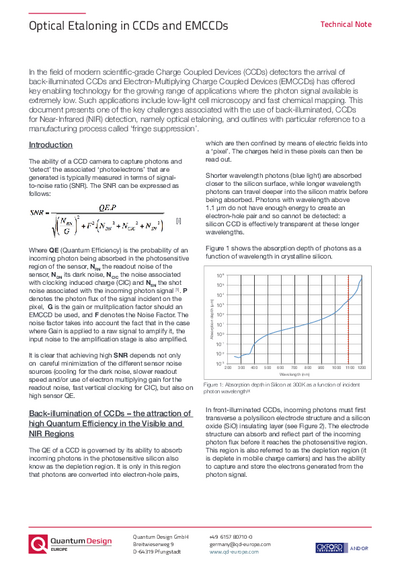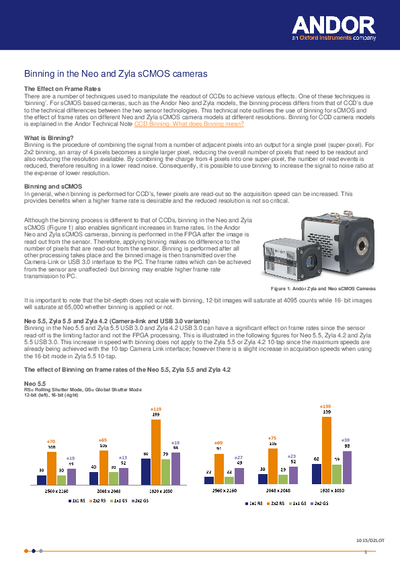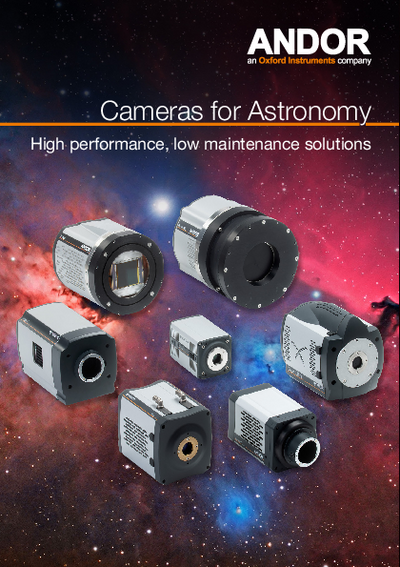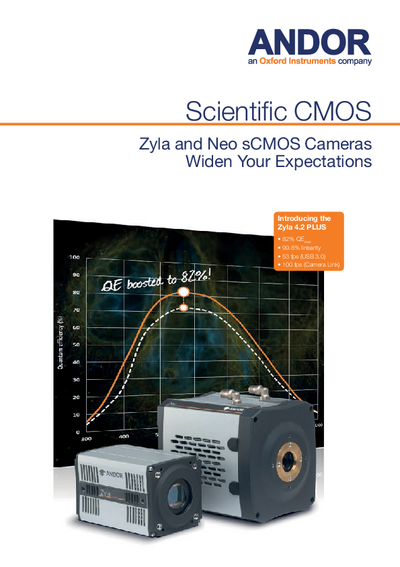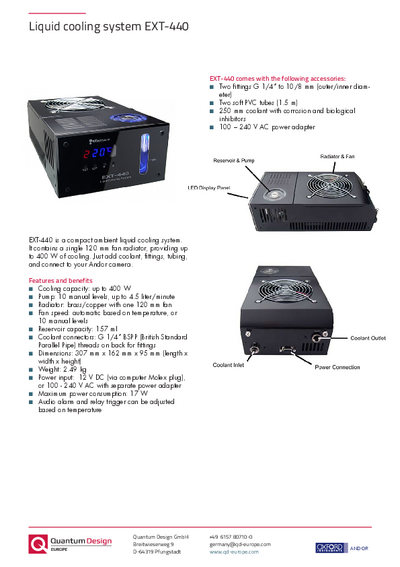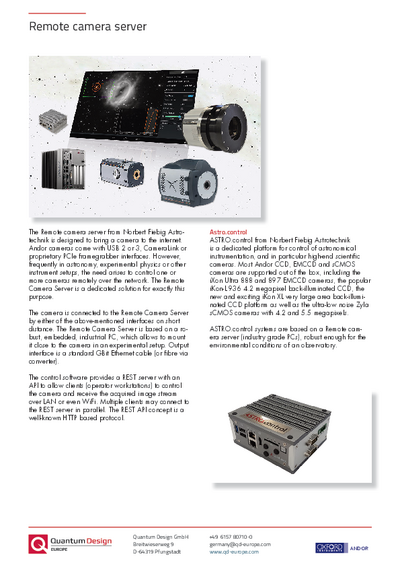sCMOS cameras
Balor, Marana, Sona and ZL41 from Oxford Instruments AndorThe Balor, Marana, Sona, and ZL41 sCMOS cameras are an advancement of the well-known CMOS technology for scientific applications. Due to their special characteristics, they are suitable for many quantitative measurement problems in physics, astronomy and biology. As all Andor sCMOS cameras have extremely low noise and high sensitivity, they can often yield a better image than EMCCD cameras - even in low light conditions. Due to its vacuum enclosure, the sensors of the Marana, Sona and Balor can be cooled to industry-leading -40 °C and -30 °C, respectively, opening up possibilities for very demanding applications. Besides the typical use for imaging, the Marana and ZL41 sCMOS cameras are very suitable for high-speed spectroscopy, especially for multi-track and hyperspectral imaging.
- Extremely low read noise of 0.9 electrons (lower detection limit than any CCD camera)
- Quantum efficiency up to 95%
- Resolution 2.0, 4.2 and 5.5 megapixels with 6.5 µm and 11 µm pixels, respectively
- Rapid frame rates of up to 101 frames/s sustained at full resolution
- High Dynamic range up to 53,000 : 1
Further information
The Balor Marana, Sona and ZL41 sCMOS cameras offer high speed, high sensitivity, and high resolution imaging performance – all at once. They can be integrated easily into research applications.
In a vacuum cooled platform, loaded with FPGA intelligence, the Balor, Marana and Sona sCMOS cameras are designed to drive highest possible sensitivity from this exciting and innovative technology development. Unlike any CMOS or CCD technology to come before it, Balor, Marana, Sona and ZL41 simultaneously deliver highest specifications in sensitivity, resolution, speed, dynamic range and field-of-view: true scientific imaging without compromise.
Based on a new and unique 16.9 megapixel sensor, Balor is a revolutionary sCMOS camera especially for astronomy with a very large field of view and exceptionally fast 18.5 ms readout. Balor is capable of acquiring up to 54 frames per second at full resolution whilst maintaining a very low <3 electrons read noise. The 12 µm pixels offer large well depth and an on-chip multi-amplifier design means the whole photometric range, from the noise floor up to the saturation limit, can be captured with one image, ideal for quantifying across a range of intensities. The 16.9-megapixel sensor of the Balor with a size of 49.5 mm x 49.2 mm offers one of the largest field of view of any sCMOS cameras on the market.
Marana and Sona employ Back Illuminated sCMOS sensors with 4.2 or 2.0 megapixels and highest available quantum efficiency of 95 %. A UV-optimized sensor delivers best sensitivity from 250 nm to 400 nm.
The ZL41 is ideally suited for many experiments that push the boundaries of speed and sensitivity, offering sustained performance of up to 101 frames per second with CameraLink interface - even faster with sub-images - and read noise down to 0.9 electrons. The ZL41’s unique dark noise suppression technology ensures the low noise advantage is maintained over a wide range of exposure conditions. The 'plug and play' interface option offers industry leading USB 3.0 frame rate performance of up to 53 frames/s at 4.2-megapixel resolution. The unprecedented value and flexibility of the ZL41 means it is also re-defining the concept of a 'workhorse' camera, rapidly displacing interline CCD cameras.
Choice of Rolling and Global (snapshot) exposure mechanisms ensure maximum application flexibility for the ZL41 sCMOS cameras with the 5.5 megapixel sensor; the latter providing a 'freeze frame' capture capability that emulates that of an interline transfer CCD camera.
Specifications
Overview of key specifications:
| Balor | Marana 4.2B-11 | Marana 4.2B-6 | Sona 4.2B-11 | Sona 2.0B-11 | Sona 4.2B-6 | ZL41 Cell 5.5 | ZL41 Cell 4.2 | |
| Resolution | 4128 x 4104 x 12 µm | 2048 x 2048 x 11 µm | 2048 x 2048 x 6.5 µm | 2048 x 2048 x 11 µm | 1400 x 1400 x 11 µm | 2048 x 2048 x 6.5 µm | 2560 x 2160 x 6.5 µm | 2048 x 2048 x 6.5 µm |
| Sensor Diagonal | 70 mm | 31.9. mm | 18.8 mm | 31.9 mm | 21.8 mm | 18.8 mm | 21.8 mm | 18.8 mm |
| Quantum Efficiency | 61 % | 95% | 94 % | 95% | 95% | 94 % | 64% | 82% |
| Read Noise | 2.9 e- | 1.6 e- | 1.1 e- | 1.6 e- | 1.6 e- | 1.2 e- | 0.9 e- | 0.9 e- |
| Sensor Temperature | -30 °C | -45 °C | -45 °C | -45 °C | -45 °C | -45 °C | 0° C or -10 °C | -10 °C / 0° C |
| Dark Current | 0.065 e-/pixel/s | 0.3 e-/pixel/s | 0.1 e-/pixel/s | 0.3 e-/pixel/s | 0.3 e-/pixel/s | 0.1 e-/pixel/s | 0.1 or 0.019 e-/pixel/s | 0.1 or 0.019 e-/pixel/s |
| Cooling | air and water or water only | air and water | air and water | air and water | air and water | air and water | air or water | air or water |
| Dynamic Range | 27,586 : 1 | 53,000 : 1 | 36,667 : 1 | 53,000 : 1 | 53,000 : 1 | 34,000 : 1 | 33,000 : 1 | 33,000 : 1 |
| Linearity | >99.7 % | >99.7 % | >99.7 % | >99.7 % | >99.7 % | >99.7 % | >99.8 % | >99.8 % |
| PRNU (Photon Response Non-Uniformity) | <0.5 % | <0.5 % | <0.5 % | <0.5 % | <0.5 % | <0.5 % | <0.01 % | <0.01 % |
| Shutter | Rolling and Global | Rolling | Rolling | Rolling | Rolling | Rolling | Rolling and Global | Rolling |
| Interface | CoaXPress (4 lane CXP-6) | USB 3.0 | USB 3.0 / CoaXPress | USB 3.0 | USB 3.0 | USB 3.0 / CoaXPress | USB 3.0 or 10-tap CameraLink | USB 3.0 or 10-tap CameraLink |
| Full Frame Rate | 54 | 48 | 43 / 74 | 48 | 70 | 43 / 74 | 40 or 100 | 53 or 101 |
Applications
Downloads
Videos
Reference customers
| Title | Author(s) | Institute | Year | Spectrograph/ Detector |
|---|---|---|---|---|
| Microsopy | ||||
| Microscopy of LEDs and phosphors in practical exercises for students | S. Bock, D. Berben | Department of Electrical Engineering and Information Technology, South Westphalia University of Applied Sciences, Hagen, Germany | 2017 | Neo-5.5-CL3 |
| Fluorescence microscopy of semiconductor nanowire arrays | S. Rahimzadeh-Kalaleh Rodriguez1, D. van Dam2, J. Gomez Rivas1,2 | 1Surface Photonics, AMOLF, c/o Philips Research Laboratories, Eindhoven, The Netherlands 2COBRA Research Institute, Eindhoven University of Technology, The Netherlands | 2014 | Neo DC152 QC-FI1 |
| Detection of electrochemically generated peroxide and superoxide by fluorescence microscopy | C. Dosche, S. Dongmo | Institute of Chemistry, University of Oldenburg, Germany | 2013 | Neo DC152 QC-FI1 |
| Imaging with scintillation screens | ||||
| Phase transitions in 1T-TaS2 mapped by ultrafast LEED | S. Vogelgesang, G. Storeck, S. Schäfer, C. Ropers | IV. Physical Institute, Georg-August-University, Göttingen, Germany | 2017 | Zyla-5.5-CL10 |
| Application of the sCMOS camera Andor Neo for X-ray and neutron imaging | N. Kardjilov1, S. Williams1,2, F. Wieder1, A. Hilger1, I. Manke1 | 1Helmholtz-Zentrum-Berlin, Berlin, Germany 2Johns Hopkins University, Baltimore, USA | 2014 | Neo DC152-QF-FI3 |
| Polarization dependent photoelectron emission with high lateral resolution | T. Wagner | Institute of Experimental Physics, University of Linz, Austria | 2012 | Neo DC152-QC-FI1 |
| Plasma- and fusion research | ||||
| Evaluation of the Zyla sCMOS imaging camera for IMSE diagnostic | O. P. Ford, C. Biedermann | Wendelstein 7-X, Max Planck Institute for Plasma Physics, Greifswald, Germany | 2014 | Zyla-5.5-CL10 |
| Measuring ion temperatures and helium densities in the hot core of a nuclear fusion reactor using sCMOS and EMCCD cameras | R. J. E. Jaspers | Department of Applied Physics, Eindhoven University of Technology, The Netherlands | 2014 | Neo DC152 QC-FI1 |
| Real-time characterization of plasma evolution by diffraction imaging | N. K. Rothe, A. V. Svanidze, C. Schuster, M. Lütgens, S. Lochbrunner | Institute of Physics, University of Rostock, Germany | 2013 | Neo DC152 QC-FI1 |
| Astronomy | ||||
| High-speed imaging and its applications: Beating down the scintillation noise | P. Ioannidis, J.H.M.M. Schmitt | Hamburg Observatory, Physics Department, University of Hamburg, Germany | 2017 | Zyla-4.2-CL10 Neo-5.5-CL3 |
| Active optical debris detection: Highly accurate position determination of space debris orbits | W. Riede, D. Hampf, P. Wagner, L. Humbert, F. Sproll, A. Giesen, | Institute of Technical Physics, Deutsches Zentrum für Luft- und Raumfahrt (DLR), Stuttgart, Germany | 2016 | Zyla-5.5-CL10 |
| Quantum physics | ||||
| Real- and momentum-space imaging of plasmonic waveguide arrays | F. Bleckmann, S. Linden | Physikalisches Institut, Rheinische Friedrich-Wilhelms-Universität Bonn, Germany | 2016 | Zyla-5.5-USB3 |
| Particle image velocimetry (PIV) and particle tracking velocimetry (PTV) | ||||
| Redesign of a 3D PTV system with ANDOR’s Neo sCMOS | P. Steinhoff, M. Schmidt, D. Müller | E.ON Energy Research Center, Institute for Energy Efficient Buildings and Indoor Climate (EBC), RWTH Aachen University, Germany | 2013 | Neo DC152 QFR-FI2 |
| Spectroscopy | ||||
| Photoluminescence spectroscopy of metal nanoantennas coupled to the atomically thin semiconductor WS2 | J. Kern, R. Bratschitsch | Institute of Physics and Center for Nanotechnology, University of Münster, Germany | 2015 | Neo-5.5-CL3 |
| Using a surface-forces-apparatus to measure force-distance profiles across confined ionic liquids | T. Utzig, H.-W. Cheng, M. Valtiner | Department of Interface Chemistry and Surface Engineering, Max-Planck-Institut für Eisenforschung, Düsseldorf, Germany | 2014 | Zyla-5.5-CL3 |
Remarks:
1New part number of DC152 QC-FI: Neo-5.5-CL3
2Neo DC152 QFR-FI replaced by Neo-5.5-CL3-F
3New part number of DC152 QF-Fi: Neo-5.5-CL3-F
Contact



